#marine mammals
Text
don't ever put them in a situation
#the last seal lol 😭😭😭#seals#marine mammals#marine mammal rescue#these noises are RIDICULOUS#i love them
73K notes
·
View notes
Photo

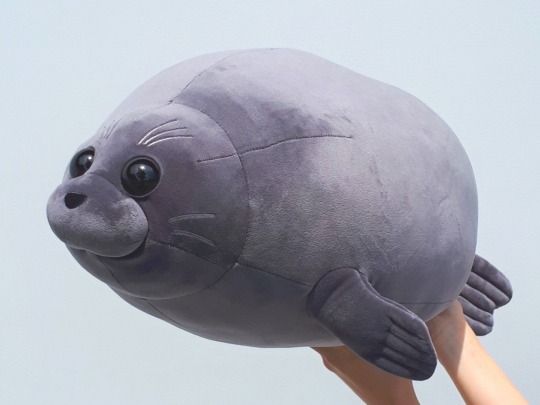


Niigata City Aquarium “Marine Pia Heart” - Baikal Seal
#plush#plushie#plushies#plushblr#plushcore#toycore#soft toy#stuffies#marine pia heart#niigata city aquarium#seal#seals#baikal seal#marine mammals#japan#plush: seal
28K notes
·
View notes
Text
Learning anything about marine mammal training will make you re-evaluate so much of your relationship with your own pets. There is so much force involved in the way we handle domestic animals. Most of it isn’t even intentional, it just stems from impatience. I’m guilty of it myself!
But with the exception of certain veterinary settings where the animal’s health is the immediate priority, why is it so important to us that animals do exactly what we want exactly when we want it? Why do we have to invent all these tools and contraptions to force them to behave?
When a whale swam away from a session, that was that. The trainer just waited for them to decide to come back. If they flat out refused to participate in behaviors, they still got their allotment of fish. Nothing bad happened. Not even when 20-30 people were assembled for a procedure, and the whale chose not to enter the medical pool. No big deal. Their choice and comfort were prioritized over human convenience.
It’s almost shocking to return to domestic animal medicine afterwards and watch owners use shock collars and chokers and whips to control their animals. It’s no wonder that positive reinforcement was pioneered by marine mammal trainers. When you literally can’t force an animal to do what you want, it changes your entire perspective.
I want to see that mindset extended to our domestic animals.
#‘oh I can walk my dog off-leash down a crowded street’ why does that matter?????#the horse world is ESPECIALLY bad about this too#edit: the whips is referring to horses I have not seen anyone whip their dog#pets#horses#animal training#dog training#dolphin training#dolphins#belugas#orcas#killer whales#cetaceans#marine mammals#zoos#aquariums#cooperative care#vet med#vetblr
1K notes
·
View notes
Text

🚨 A team of scientists, led by Phil Morin of NOAA, have published a new paper formally proposing two “new” species of killer whale: Bigg’s killer whales (Orcinus rectipinna) and resident killer whales (Orcinus ater).🚨
More than fifty years ago, researchers began studying the killer whales found off the west coast of North America. One keen-eyed scientist, Dr. Michael Bigg, noticed that there appeared to be two kinds of killer whales: a smaller, more gregarious form that fed on fish and a larger, stealthier type that fed on marine mammals. He and his colleagues dubbed the fish-eaters “resident” killer whales and the mammal-eaters “transient” killer whales (who were later renamed Bigg’s killer whales in his honor).
Two female Bigg’s killer whales in Washington (top) and a male and female resident killer whale in Alaska (bottom)
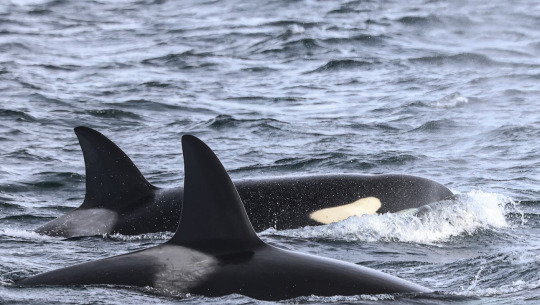

Many decades later, scientists have been hard at work trying to resolve whether or not these two forms are different species. It is not an easy task. This requires a thorough investigation into many factors, including evolutionary history, genetics, morphology, ecology, and behavior. In this paper, the researchers lay out all of the evidence and conclude that these two forms warrant elevation to species status.
As newly proposed species, both need new scientific names. There have been numerous killer whale species proposed and described in the past by other naturalists and researchers, including those in the North Pacific. Unfortunately, there are no type specimens— individual specimens upon which the first descriptions of a species are based—available for killer whales previously described from the North Pacific, so the researchers were left to examine drawings and illustrations of killer whales in the North Pacific in the late 1800s by Scammon and Cope.
The authors propose “Orcinus rectipinnus” for Bigg’s killer whales and “Orcinus ater” for resident killer whales. “Rectipinnus” presumably refers to tall dorsal fins, and “ater” means “black” or “dark” in Latin. Of note is the fact that a female killer whale from California originally examined and described by Scammon as “Orcinus rectipinnus” had seals in her stomach, suggesting she was a Bigg’s killer whale.
In addition, the authors note they are consulting with Indigenous tribes for a new common name for resident killer whales.
What’s next? In marine mammal biology, proposed taxonomic changes are reviewed by the Society for Marine Mammalogy’s taxonomy committee. If accepted, these species revisions become “official.” This has been an eagerly awaited paper by many in the field of killer whale biology and it is a great accomplishment, made possible by decades of research by scientists around the world.
A big thank you to lead author Phil Morin for letting me preview the manuscript and for answering my numerous questions in preparation for this post!
Read the paper here!
#killer whale#orca#science communication#marine biology#marine mammal#cetaceans#marine mammals#orcas#whales
535 notes
·
View notes
Text
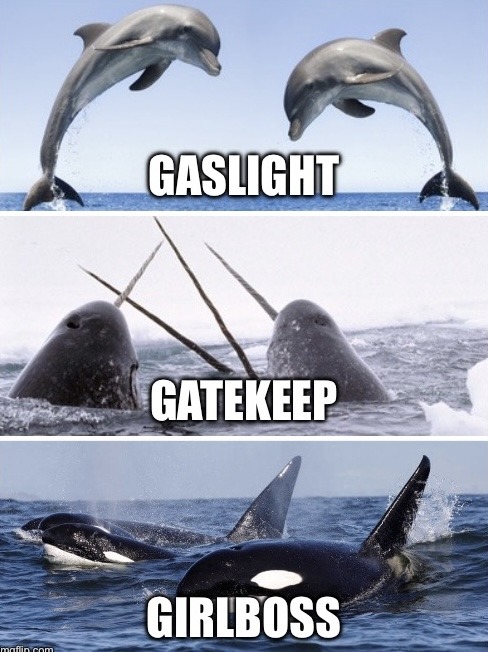
gaslight, gatekeep, girlboss: cetacean edition
#marine biology#marine mammalogy#marine mammals#cetaceans#marine biology memes#cetacean memes#dolphins#bottlenose dolphin#narwhal#orca#killer whale
3K notes
·
View notes
Text

I don't think I ever uploaded this on here!
some seals
#seals#sea lions#marine mammals#pinnipeds#digital art#artists on tumblr#digital artist#design#sea lion#seal#harbor seal#female artists
1K notes
·
View notes
Text
Wet Beast Wednesday: walrus
There are a lot of iconic arctic animals, such as the polar bear and narwhal, but my personal favorite is the walrus. Known for their large tusks, prominent whiskers, and habit for busting myths creepy eyes, walruses are unique amongst the pinnipeds. Most people know of the two main groups of pinnipeds: Phocidae, the earless or true seals and Otariidae, the fur seals and sea lions. Walruses however are in a class of their own, being the only surviving species of their own family: Odobenidae. A weird fact that I learned researching for this is that taxonoimists used to think Odobenids evolved from bears before later reclassifying them alongside the other pinnipeds. Old-timey taxonomy was wild and came up with some absolutely unhinged ideas. Like they used to think that microbats and megabats weren't related, instead classifying megabats as primates.

(image; a walrus sitting on an ice flow. It is a large, brown mammals with short limbs that end in flippers. Its head has a wide, blunt snout and two long tusks emerging from the upper jaw)
There is one species of walrus, Odobenus rosmarus, divided into two subspecies based on location: the Atlantic walrus (O. r. rosmarus) and Pacific walrus (O. r. divergens). The two subspecies are still very similar and genetic testing indicates they diverged between 750,000 and 500,000 years ago. There used to be a third listed subspecies from the Laptev sea, O. r. laptevi, but they have since been reclassified as a population of the Pacific walrus. Walruses are very large, being the third largest pinnipeds after the two elephant seal species. The Pacific subspecies is larger than their Atlantic brethren with most males reaching an average weight between 800 and 1,700 kg (1,800 to 3,700 lbs). A few males have been known to grow considerably larger than average. Male Atlantic walruses average about 900 kg (2,200 lbs). In both subspecies, females are about 2/3 the size of males and have shorter tusks. a large portion of their weight comes from the thick layer of blubber under their skin that helps them stay warm. Both subspecies have an average length between 2.2 and 3.6 meters (7.4 to 11.8 ft). Walruses have hind flippers that can turn forward to act like feet, letting them crawl on all fours like sea lions. Like true seals, they have no external ears. The skin is very thick and mostly bald. They are born with brown skin that becomes lighter as they age. While swimming, the blood vessels in the skin construct to reduce blood flow and limit heat loss, which makes them considerably lighter, almost white. Males have skin nodules called bossed around the neck and shoulders. Their creepy eyes are the result of eye sockets with no roof and powerful extraocular muscles that let the eyes protrude out of the skull and look both forward and sideways. The famous mustaches are composed of 400-700 thick whiskers. The whiskers are attached to muscles and have both nerve ending and blood supply. They are incredibly sensitive sense organs and a walrus can identify objects as small as 2mm with its whiskers. Their lips are muscular and flexible and aid in creating a large variety of noises.

(image: a close-up of a walrus's face, showing its prominent whiskers and small eyes. Its mouth is open, revealing its tongue)
youtube
How come the walrus can whistle but I can't? (video: a walrus in a zoo being instructed by its handler to make multiple vocalizations)
Of course the most famous features of walruses are their tusks. These two large canines can reach a meter in length and are larger in males than females. The tusks have a number of uses in both sexes, though males use them more. In both sexes, they are used to help dig breathing holes in sea ice, hang onto ice and help the walrus climb out of the water. Males also use their tusks in displays of dominance, especially during mating season. Larger tusks are a sign of dominance and typically the walrus with the largest tusks will win standoffs. If a standoff escalates from posturing to a fight, they will use their tusks as weapons. They tend to strike around the neck and shoulders and the skin nodules in those areas help protect males from each other's tusks. It was formerly believed that walruses would use their tusks to dig for prey on the sea floor, but this is no longer believed to be the case.

(image: a walrus skull showing the tusks)

(image: a walrus using its tusks to hang onto the ice and keep its nostrils above the water)
Walruses spend a lot of their time searching for the food they need to support a body that big. They prefer forging along the continental shelf and spend much more time in shallow water than other pinnipeds. While walruses have been tracked diving 500 meters deep, the majority of dives are much more shallow. The vast majority of a walrus's diet consists of seafloor-dwelling invertebrates including tubeworms, soft corals, tunicates, crabs and shrimp, sea cucumbers, and mollusks. While that's a wide palette, their absolute favorite food is clams. To hunt, walruses drag their noses and the forward surface of their tusks through the sediment and use their whiskers to search for food. This stirs up the sediment and releases nutrients back into the water column, a process balled bioturbation. Many foods can be swallowed whole or chewed, but they have a special feeding style for clams and other bivalves. Walruses will hold the bivalve in their mouths and use their flexible lips to form a water-tight seal around it. It then withdraws its tongue into its mouth to create enough suction to suck the bivalve meat right out of the shell. So important is this strategy to feeding that the shape of their mouths is specially adapted to it. Walruses are also known to feed on seals, though how much of that is due to hunting or scavenging is unknown. Additionally, they will scavenge whales, may hunt walrus trapped under sea ice, and have been seen catching and eating birds.
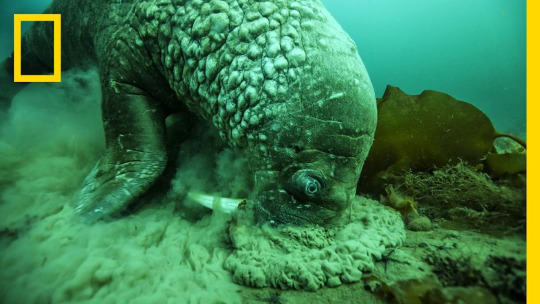
(image: a walrus foraging for food underwater. It has its snout pressed into the sea floor and is kicking up a large amount of sediment. Still from a National Geographic video)
Walruses are social and migratory, traveling south for the winter and north for the summer in aggregations that can be tens of thousands strong. They will haul out onto land or sea ice in huge numbers, blanketing the landscape in blubber and tusks. While these aggregations are preferred, they are not considered a true social species as they do not aid each other when together. Walruses on land or ice are skittish and will spook easily. Being startled can lead to stampedes while the walruses flee back to sea. Sometimes, walruses will be trampled to death during these stampedes. During mating season, the normally cordial walruses become much less friendly to their neighbors. Breeding seasons lasts from January to March. During this time, males will gather in the water around females in heat and compete for the change to get to that nice walrussy (I will not apologize). This is usually done via bellowing and posturing with the tusks, but may escalate to fights. While males become sexually mature around age 7, they often do not become large and strong enough to secure mates until around age 15. Females become sexually mature between 4 and 6 years old. Curiously, females enter heat twice per year, but males are only fertile once per year. Gestation takes up to 16 months and calves are born able to swim and weighing up to 75 kg (165 lbs). Females with calves move away from the large aggregations, possibly to keep their calves from being crushed in stampedes and possibly to make it harder for predators to detect their scent. Nursing lasts for over a year, longer than in many pinnipeds. Walrus milk is fattier than that of land mammals, but less fatty than that of true seals, forcing walrus mother to nurse longer. Even after being weaned, walruses may spend up to 5 years with their mothers. Females only mate at most every two years, which gives the walrus the lowest reproduction rate of all pinnipeds. Walruses can live up to 30 years in the wild and 40 years in captivity. Male walruses have the largest penis bone of any non-cetacean both in absolute size and proportionately.
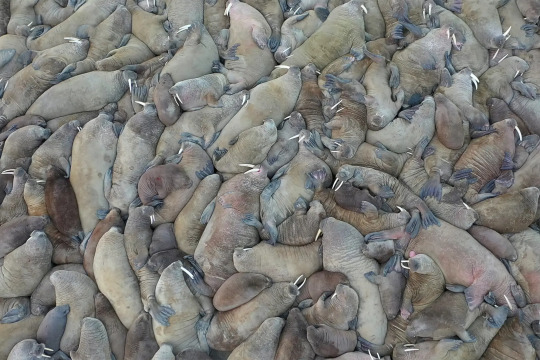
(image an aerial shot of a walrus herd on land. There are many walruses and they are so tightly packed together that no ground is visible)

"Don't talk to me or my son ever again" (image: a mother walrus with its calf. The calf is a smaller version of the mother with no tusks. The calf is sittting by its mother's side. Both are looking at the camers)
Walruses have been hunted by humans living in the arctic circle for millennia. Hunting peaked in 18th and 19th centuries when there was a high commercial demand for meat, blubber, skin, and ivory. This almost led to the extirpation of Atlantic walruses. Since then, hunting has been outlawed except by indigenous peoples, allowing the populations to recover. Now, the major threat to walruses is climate change leading to loss of sea ice needed for hauling out and breeding. The IUCN lists both subspecies as Vulnerable. They were an important source of food and other materials to the peoples of the arctic circle and appear frequently in the mythology of said peoples.

(image: a walrus tusk carved with the images of multiple fish, seals, and polar bears)
#wet beast wednesday#walrus#pinniped#marine biology#zoology#ecology#marine mammals#animal facts#biology#Youtube
503 notes
·
View notes
Text

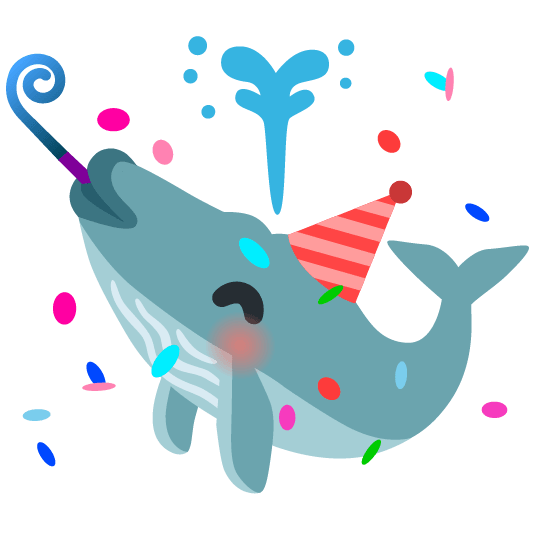

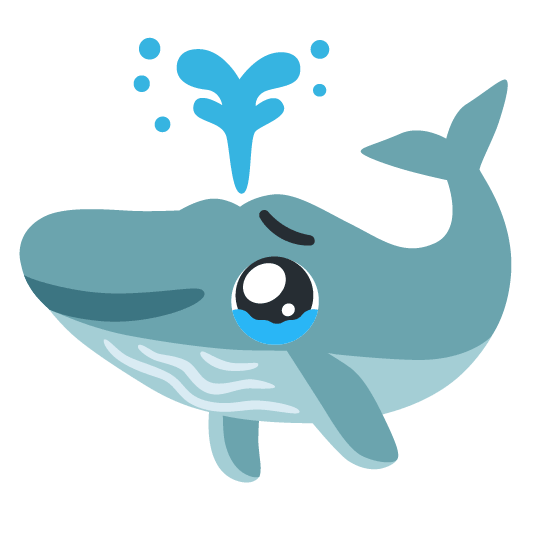




some whales i made in emoji kitchen
711 notes
·
View notes
Text
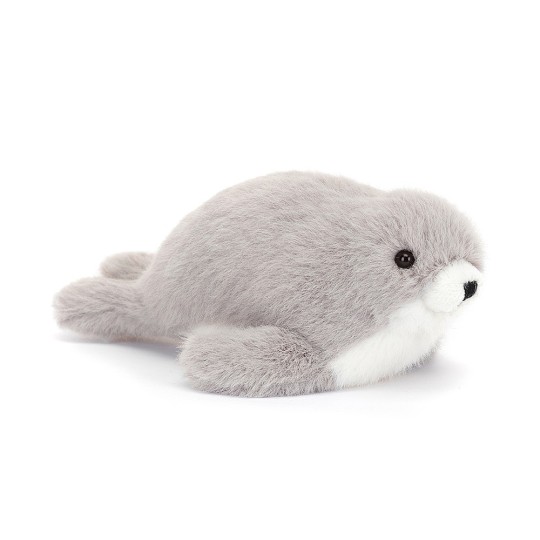





Nauticool Grey Seal, Nauticool Spotty Seal and Nauticool Roly Poly Seal
Ko-fi / Instagram
#stuffed animals#stuffies#stuffed animal#jellycat#jellycats#jellycatlondon#jellycatstuffies#jellycatplush#seal#seals#marine mammals#seal plush#cute#plush#plushies#plushblr#plushcore#plushie#plushiecore#stuffiecore#allplush#plush toy#plush toys#soft toy#soft toys#toycore#kidcore#grey#white
2K notes
·
View notes
Text

ah, excuse me-

*deep breath*

AAAAAAAAAAAAAAAAA

ahem
332 notes
·
View notes
Photo
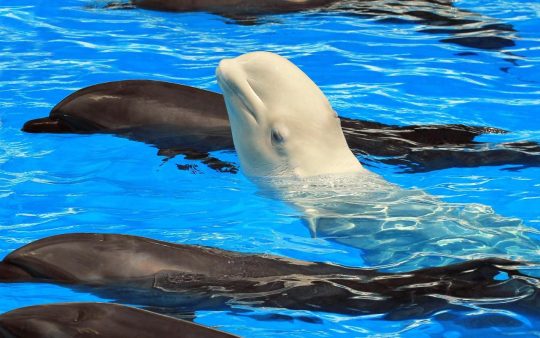
Scientists believe that the remarkable intelligence of beluga whales is demonstrated by their ability to learn and communicate using the complex language of whistles and clicks. This has been observed in a specific case where a beluga whale, living in captivity alongside a pod of bottlenose dolphins, has successfully acquired and adopted their unique language.
(via Beluga whale learns to 'talk' to pod of bottlenose dolphins )
#animals#beluga whale#dolphin#whale#intelligence#communication#language#bottlenose dolphins#cognitive abilities#marine mammals#mixed-species environments#interactions
282 notes
·
View notes
Text
do not ever separate them again <3
3K notes
·
View notes
Photo
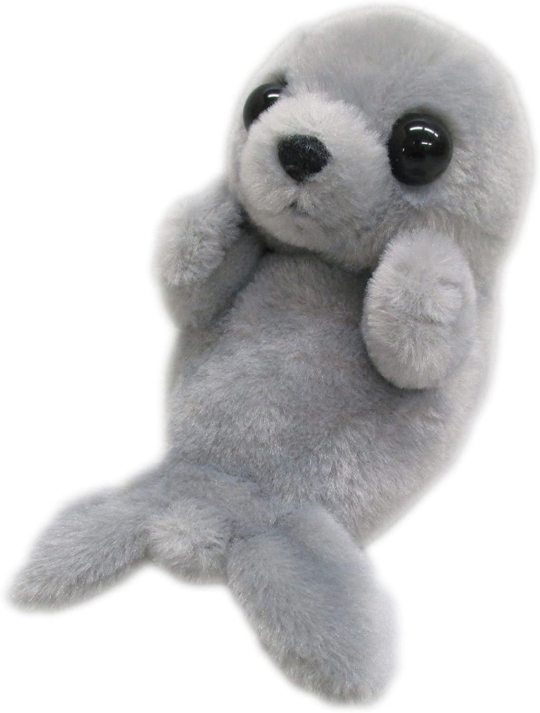
San-ei Boeki Baikal Seal
#plush#plushie#plushies#plushblr#plushcore#toycore#soft toy#stuffies#seal#seals#baikal seal#marine mammals#san-ei#plush: seal
9K notes
·
View notes
Note
Can you elaborate the story of the ”Free Willy” orca (forgot his name). From my understanding the orca couldn’t survive in the wild and imprinted on hunans to the point that he seeked out human compaionship
Oh Keiko. His is a sad story. In 1979, he was tragically captured from his native Icelandic waters as a calf and, after bouncing around for several years, was sold to an amusement park in Mexico City that would eventually become Six Flags Mexico. It was here that he found fame as the star of Free Willy, a very sweet and very fictional story (a favorite of mine as a child!) that later spawned a trilogy, all while convincing the public that it’s easy to free a whale.

The tank you see in the movie is the same tank Keiko lived in during his time in Mexico. Intended to house dolphins, it was incredibly undersized, and the water was far too warm for an orca. Worst of all, he was isolated from others of his kind, with only the companionship of his human caregivers and a few bottlenose dolphins. The years of poor husbandry took their toll on poor Keiko, and he was lethargic and in ill health when his story because known throughout the world.
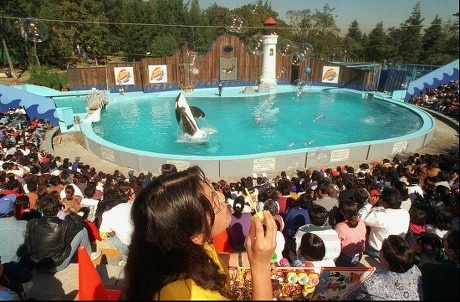
Although many parties were involved in what happened next, Warner Bros. studios (the filmmakers behind Free Willy) and the Humane Society of the United States (HSUS, my beloathed) were at the forefront. Once it became public knowledge that the real Willy was not, in fact, returned to the wild to live with his family and was still living in that too-tiny pool, many of Keiko’s fans (mainly children) began writing letters asking for their favorite cetacean movie star to be released.

Doesn’t that warm your heart? *she says sarcastically*
Some time—and an incident in which Michael Jackson (yes, that Michael Jackson) tried to purchase the whale for his personal collection—later, Keiko’s owners relented. It was decided by the newly formed Free Willy-Keiko Foundation, founded by Warner Bros. and cell phone mogul Craig McCaw (and still in operation to this day, unfortunately), that it was time to make fantasy a reality and set Keiko free. In 1996, Keiko was transferred to the Oregon Coast Aquarium for rehabilitation, where he would spend two years.


Under the quality husbandry and veterinary care Keiko received in Oregon, his health began to improve. In my opinion, this beautiful habitat, with trainers who loved and cared for him, should’ve been his forever home. One would think this was the plan all along, considering his trainers were still doing waterwork with him. That doesn’t exactly scream “this animal is a candidate for release!”

But the HSUS and Free Willy-Keiko Foundation had promised the children of the world that Keiko would return to the wild. Think of the children, people.

In 1998, Keiko tasted the crisp saltwater of the Icelandic seas for the first time in nearly two decades. For the next four or so years, Keiko lived in a sea pen, with the intentions of gradually habituating him back to his native environment. Over time, his trainers took him on longer and longer “walks” in the open ocean. One day in 2002, the walk didn’t end.
Keiko was free.
15 months later, he was dead.
The cause of death was pneumonia, the most common disease of cetaceans both in the wild and in human care. He was 27 years old (average life expectancy of a male orca is about 30 years).
Perhaps it would’ve been worth it, had Keiko spent those last 15 months with his long-lost family. But he didn’t. Though he was occasionally observed trailing pods of orcas, Keiko never rejoined a wild pod. Instead, he spent those 15 months traveling the coasts of Iceland and Norway seeking out the only family he knew. Humans.

Keiko would approach swimming children, allowing them to ride on his back as he had with his trainers over the years. He would follow boats in search of food and companionship, as his caregivers had interacted with him from boats during his ocean walks. These escapades became so frequent that the local government passed ordinances to stop its citizens from interacting with the whale. Although the HSUS claimed otherwise, Keiko was never again a truly wild whale. He was a whale dependent on humans, humans who ignored the advice of experts and tried to bring fiction to life. In 2009, the journal Marine Mammal Science did a retrospective review of Keiko’s rehabilitation and release. They determined it was a failure.
Despite this, Keiko remains a poster child for anti-zoo activists. The still-hypothetical Whale Sanctuary Project (my even more beloathed) uses Keiko as an example of why their experiment is a good idea, tugging at heartstrings of well-meaning animal lovers like HSUS did all those years ago.

In reality, Keiko was quite possibly the worst candidate imaginable for release. He was a fully mature male, with a history of poor health, who had spent decades in the care of humans with absolutely no contact with others of his kind since he was basically a toddler. The decision to release him was made entirely on emotion and carried out by movie executives and animal rights activists. For further insight into the political and financial woes of the release, I highly recommend Killing Keiko by Mark Simmons, one of Keiko’s caregivers throughout the rehabilitation process.
RIP Keiko. You were a beautiful, sweet man who inspired millions 🐳
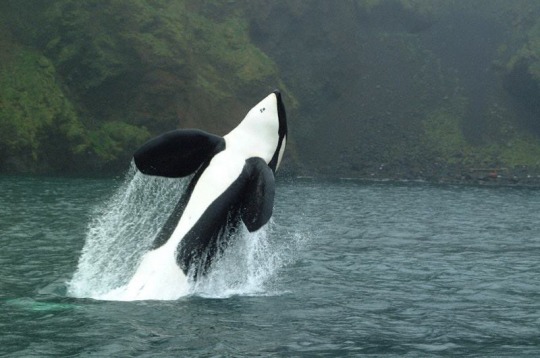
#keiko#free willy#orcas#killer whales#cetaceans#marine mammals#killing keiko#humane society of the united states#whale sanctuary project#answered asks
9K notes
·
View notes
Text

A juvenile elephant seal napping on Point Reyes National Seashore
#seals#pinnipeds#mine#elephant seal#marine mammals#wildlife#nature#nature photography#naturalist#ecology#north america#animals#photography#california wildlife#point reyes#national parks#national park#seal#wildlife biology#marine biology#marine animals#marine life#marine biologist#California#bay area#northern california#norcal#ecologist#wildlife biologist#ocean
222 notes
·
View notes
Note
Do you do marine mammals as well? I would like to know your chunk funk gunk rating of my beloved Orcinus orca
Today on CHUNK! FUNK! GUNK! We rate
the ORCA WHALE:

9.3/10 Chunk
10/10 Funk
1/10 Gunk
Orcas! They’re so cool- though they aren’t actually whales. Orcas are dolphins, but they’re so big that they’re referred to as whales.
Their chunk is incredible, but only dampened by the fact that they do indeed have bones. High chunk. Orcas are iconic, look at that bold black and white patterning; Their beautiful smiles; and their incredible brains… maximum funk. From my brief research, it seems that Orcas do secrete mucous, but it’s the normal way mammals do (eyes, internal organs, etc.) so they get low gunk.
Overall Rating: 9.7/10
I’ve never had too much of an interest in orcas (it was mostly from my “not like other girls” mentality holding me back from enjoying popular things) but they’re REALLY cool. They’re so incredibly smart and their hunting patterns are amazing.
My favorite orca related fact is that the biggest predators (physically, not numerically) for the North American Moose are orca whales!!
#chunk funk gunk#chunk#gunk#funk#asks open#orca whale#orca#killer whale#orcas#ocean animals#ocean#marine mammals#ocean mammals#dolphins#whales#dolphin#whale
194 notes
·
View notes